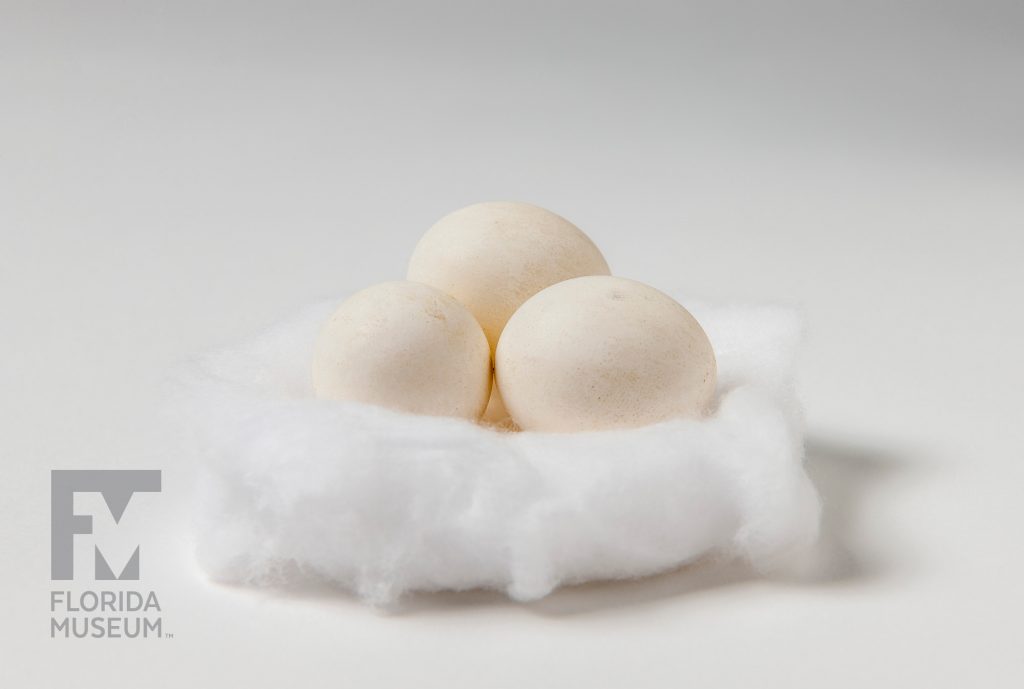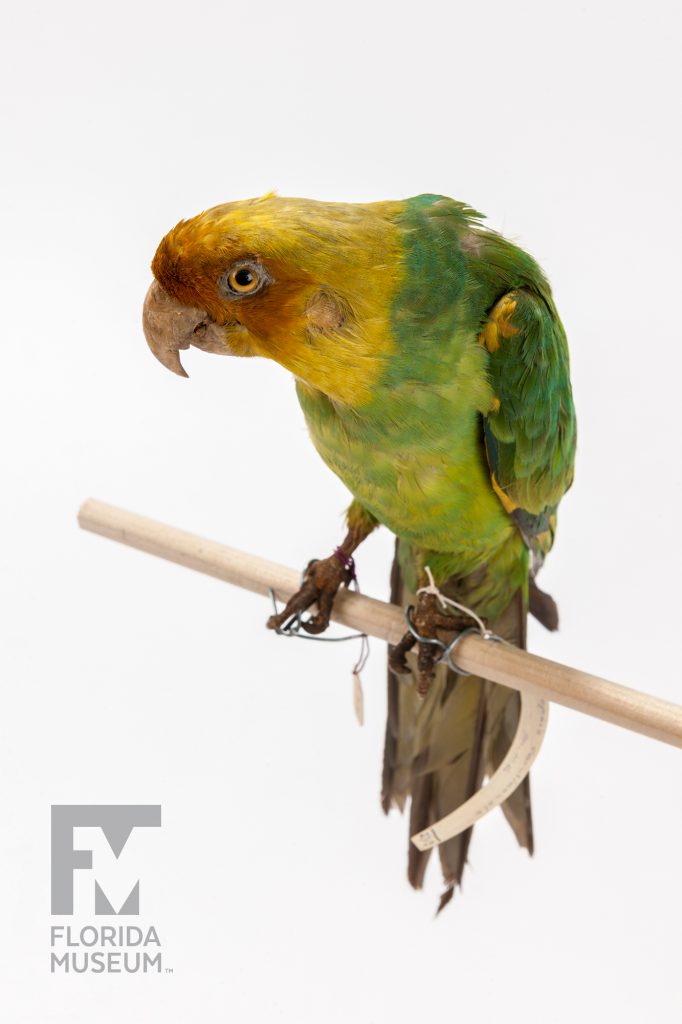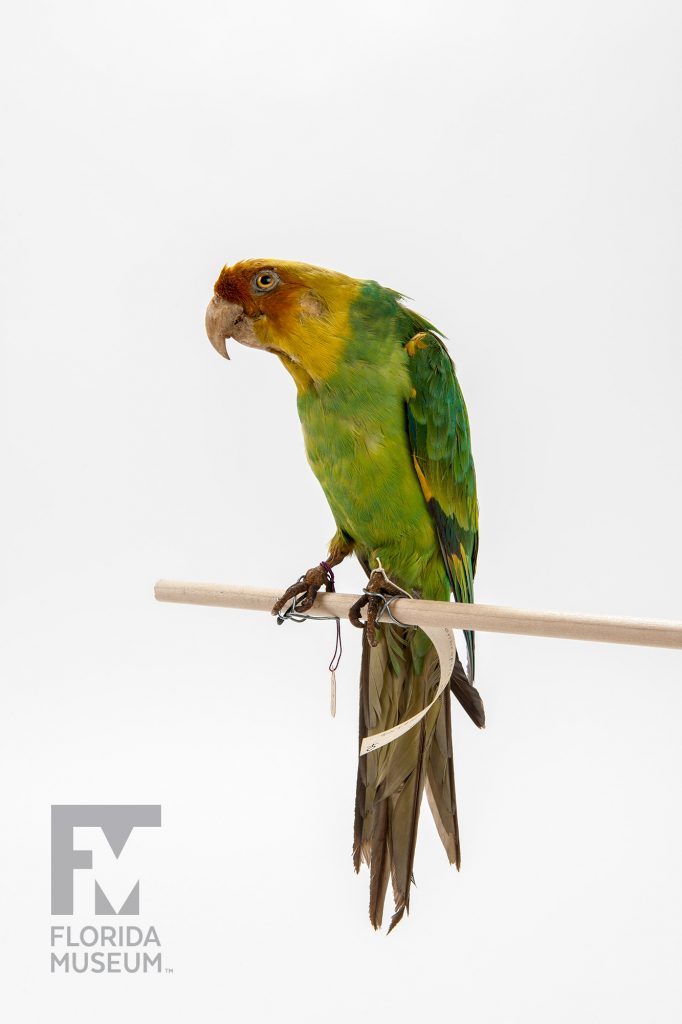Naturalists noticed declining populations of the once-common Carolina Parakeets as early as the 1830s. By the end of the 19th century, they were restricted to Florida. These eggs, collected on the Kissimmee Prairie, may be the last sign of this once common bird.
Summary
Carolina Parakeet Eggs (Conuropsis carolinensis)
Collected in Okeechobee Co., 1927
Collection
Story
The Carolina Parakeet was the only Parakeet native to eastern North America. It probably ranged from as far west as Colorado north to the northern part of the Midwest, east to the Eastern Seaboard and south to Florida – which may have been actually the stronghold of its population in numbers of individual birds.
Considering that it – at one time – was such an abundant and widespread bird, it’s remarkably little-documented because it disappeared so fast after it first came to people’s attention. Naturalists began noticing sharp declines in its numbers as early as the 1830s, which was not very long after naturalists started paying serious attention to any birds in North America. And by the late 1800s was considered to be just about gone from nearly all of its range.
The latest sightings, whether credible or otherwise, tend to come from Florida. And the set of eggs that we have here is the latest documented evidence of the existence of the bird anywhere in the wild. These eggs were collected by our curator Charles Doe on the Kissimmee Prairie in 1927. They are certainly the last specimens ever collected. There have been a few site records reported later than that but they are not well-documented and generally are highly dubious.
These eggs for a long time were highly controversial, but then in the 1980s and 1990s Dr. Noel Snyder, a longtime Florida naturalist, searched out many of the longtime residents of the southern part of the Kissimmee Prairie who actually knew Charles Doe – who knew the area intimately – who had seen Carolina Parakeets in their natural habitat on the Kissimmee Prairie. And he is now convinced from the corroborating details provided by these witnesses that Doe’s collection of this set – and another one in the same year – are indeed authentic and represent the last egg sets to be collected in North America.
At that time, the southern Kissimmee Prairie was one of Doe’s regular collecting haunts in Florida, and he was not the kind of person to advertise his finds, which is an important point really because it adds to the credibility of this record since he was not the kind of person who would use them to advertise his accomplishments or magnify his ego in the company of other people. He kept most of his collecting records entirely secret, and so the fact that he did not publicize these records is another point in their favor, and they have lain in our collection ever since, with people arguing about them decade after decade. And Dr. Snyder’s latest opinion on the subject seems to be the one that is going to carry the day.
It is conceivable that some time not very far off it will be possible to extract DNA from these eggs. It’s not yet possible to do that nondestructively, but we hope that someday we’ll be able to get DNA out of these eggs and come to a firm conclusion about whether that’s actually what they are.
Tom Webber
Collection Manager, Ornithology*
Florida Museum of Natural History
Exhibit
On display Sept. 23, 2017-Jan. 7, 2018, Rare, Beautiful & Fascinating: 100 Years @FloridaMuseum celebrated the Museum’s rich history. Each Museum collection was asked to contribute its most interesting items and share the stories that make them special. Though the physical exhibit is closed, this companion website remains online, providing an opportunity to experience the Florida Museum’s most treasured specimens.
Exhibit Area: Extinction
Theme: Extinct Birds
 Want to see more? Explore more than 300 breathtaking color photos of plants, animals, fossils and cultural heritage materials from the Florida Museum of Natural History’s collections in the award-winning book All Things Beautiful available from the University Press of Florida.
Want to see more? Explore more than 300 breathtaking color photos of plants, animals, fossils and cultural heritage materials from the Florida Museum of Natural History’s collections in the award-winning book All Things Beautiful available from the University Press of Florida.
*This title was accurate at the time the exhibit was on display in 2017. Please visit the collection website to verify current staff and student information.


